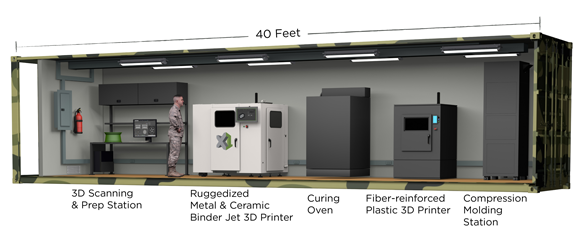ExOne developing portable AM system for US Department of Defense
February 17, 2021

The ExOne Company, North Huntingdon, Pennsylvania, USA, has been awarded a US Department of Defense (DOD) contract to develop a fully operational, self-contained Additive Manufacturing system, housed in a standard shipping container of up to 12.2 m (40 ft) long.
Alongside ExOne, Dynovas, Inc, Dover, Delaware, USA, (specialising in materials engineering, composites manufacturing and DOD weapons systems) and Applied Composites (AC), San Diego, California, USA, (provider of complex components, assemblies, engineering and tooling) will also be utilised in the production of the pod, with AC’s Reinforced Additively Manufactured Compression Assisted Molding (RAMCAM) system an enabler to the project.
Currently under development, the AM system pod will be deployed directly in the field to manufacture parts in support of war theatres, disaster relief or other remote operations. To meet the demands of these locations, ExOne is developing a special military edition AM machine capable of Binder Jetting (BJT) more than twenty materials (including metal, ceramic and composites) into direct final products or tooling. This upgraded machine will also have a unique body style and other features to make it a more rugged product.
“Binder Jet 3D printing is a critical manufacturing technology for military use because of its speed, flexibility of materials and ease of use,” stated John Hartner, ExOne’s CEO. “We’re excited to collaborate with the US Department of Defense and other partners to make our 3D printers more rugged for the military, which will also benefit our other manufacturing customers. Most importantly, we know that years from now, our technology will play an important role in filling critical needs quickly.”
A digital library of parts for AM can be stored electronically, as opposed to keeping spare parts physically stored in a depot. And, when dealing with older parts without a readily-available digital file, items can be easily 3D scanned before being additively manufactured in the field. What’s more, parts needed to solve unique problems could also be designed digitally and additively manufactured as needed.
By enabling a military team to additively manufacture parts as needed, on-site, downtime can be reduced from weeks or months to only a few days or less; ideally, military personnel would be able to additively manufacture a digital file of a broken or damaged part and have a finished product in less than forty-eight hours, without conventional tooling, in the self-contained pod. On top of saving critical time, cost and waste would also be reduced.
















